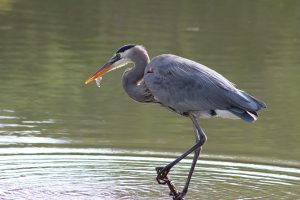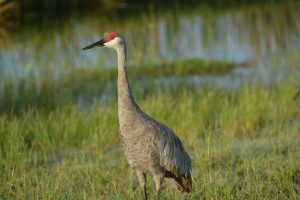
Great Blue Heron
A lot of my family and friends know that I love the birds and know a little bit about them. If I don’t my serious birder husband definitely does as he keeps bird lists of birds that he has seen in our backyard, in the county that we live in, the state that we live in, and all other states that we have been to. I would say that he definitely knows his birds more than me.
So of course when someone sees an interesting bird they like to tell us about it. One bird in particular, the Crane, stands out as we have been told by quite a few people that they saw one at one time or another. They tell us that they were walking along the beach, or by a lake or pond, and they saw a Crane feeding or walking at the water’s edge. Of course when we hear this we immediately know that it is not a Crane but a Great Blue Heron.
How do we know? It is because Great Blue Herons are year round birds in pretty much all of the United States. Cranes on the other hand are usually only seen during their migration time (late September through December) where we live in Kentucky. If you are lucky enough, you may see Sandhill Cranes in flocks flying over as they move south from their northern breeding areas for the winter. So yes some people may be correct when they say they have seen a Crane and that’s why we always ask questions just to make sure.

Sandhill Crane
How can you tell the difference between a Heron and a Crane?
Great Blue Herons and Cranes do look very similar with their long legs and long neck but they are not in the same family. So it is understandable that people get them confused. Here are a few ways to tell them apart:

Sandhill Cranes in flight

Great Blue Heron in flight
One sure way is to look at their necks. A Crane’s neck is shorter than the Heron and when flying they stick their neck straight out. The Heron curves its neck into an “S” shape and it is pulled all the way back when flying.
Cranes have shorter beaks than herons.
Another way is by their behavior. Crane’s travel in flocks together in wide open places and do not go in trees. Herons are more solitary birds and generally are seen alone. Herons will perch and nest in trees as well as marshes, ponds, riverbanks, and fields.
You will see Great Blue Herons all year long around lakes, ponds, and beaches but you will not necessarily see a Crane (depending on where you live) This is because we only have 2 types of Cranes in North America which are the Sandhill Crane and the Whooping Crane. The Whooping Crane is endangered with about 220 documented birds so it is going to be less likely to see one. Sandhill Cranes live way up North during breeding season, migrating more south from about late September through December.
More Facts About Great Blue Herons
Great Blue Herons live in both freshwater and saltwater habitats feeding on fish, reptiles, insects, and other birds. They can also be seen in grasslands and agricultural fields stalking frogs and small mammals.
The oldest Great Blue Heron lived to be 24 years old. Most live to be 15 years old.
Great Blue Herons can be anywhere from 3 to 4.5 feet tall. Their wingspan 5.5 to 6.6 feet.
They can quickly strike prey at a distance with their specially shaped neck vertebrate.
They can hunt both day and night with their specially adapted eyes.
While Great Blue Herons are very solitary birds they will nest in colonies.
Male Herons are monogamous birds but find a different mate each year.
Herons nest not only in trees but also on land using grass to build their nest instead of sticks.
In Conclusion
The Great Blue Heron is a stately looking bird that is very similar to the Crane, another stately bird. Both birds are grayish in color, have long legs, and long necks. Many people mistake Herons for Cranes because of this but they are not of the same family. Cranes are taller but have shorter necks and beaks. When flying Cranes stick their necks straight out while Herons curve their neck into an “S” shape and pull it way back.
Herons are solitary birds that you can see along the shoreline of a lake, beach, or pond. They like to perch and nest in trees, marshes, and riverbanks. You may also see them in fields as they like to feed on frogs, birds, and small mammals.
On the other hand, Cranes are generally seen in large flocks in open lowlands and agricultural fields. They eat small rodents, fish, amphibians, insects, grain, berries and plants.
Whether you see a Great Blue Heron or a Crane you can’t go wrong. Both are majestic birds that are great to see in the wild!
Can you tell the difference between a Heron and a Crane? Do you have any comments that you would like to make about this post? I would love to hear from you. Please do so below.



Thank you, you were very helpful. We fish alot around Indian lake in Ohio and have seen so many herons. In different locations. They also dive, which is fascinating.
this so bird are eating my koi. fish how can I protect my koi pond from there great big birds
Frank, my brother had the same problem a few years ago. He put a fake great blue heron by his pond and says that it has helped keep the herons away. However, I also found this link which has a few more suggestions. https://www.thepondguy.com/product/learning-center-pl-article-how-to-deter-herons/learning-center-pl-predator-control?p=PPCGOOGA&gclid=CjwKCAjwo9rtBRAdEiwA_WXcFgBjceqWdgdSkYEA38FHpUjqmdPj8M18SGsoZ80nrb7lJjRRj90ShRoCS5sQAvD_BwE Just copy and paste it into your browser. I hope that this helps.
Thanks for your comments.
Very helpful distinctions. I definitely saw blue herons as opposed to the cranes I previously thought! Such beautiful prehistoric looking creatures.
Hi. Thanks for a great article. Very informative and much appreciated. I live in the Piedmont of North Carolina in the city of Charlotte on a 5 acre wooded lot. Today I saw a beautiful blue heron fly from a perch high in a tree, showcasing its majestic wing span. Since the lot I live on is densely wooded, I am accustomed to seeing owls, red tail hawks, and a number of other beautiful birds of prey, as well as other native species but this was my first time seeing a blue heron. I thought it odd that it would be so close to the city, and in the woods as I believed them to live closer to the Coast or near agricultural fields. Why is the Blue Heron hanging out in the woods in the city?
Robin, is there a pond nearby somewhere or a creek? Great Blues can be seen around them. They do not need a huge body of water. We get them at our pond frequently as they like to fish for food. As long as there is fish to be had there will be a Great Blue Heron. Thanks for your post.
This very helpful. We recently moved to the Lowcountry (wetlands and marshes) of South Carolina and see what we now know is a blue heron just about everyday at the pond in our back yard. They’re is always just one, “standing on guard” on the side of the pond. We also see other white birds that are likely egrets, skillfully and craftily fishing in the pond. There is usually an alligator nearby in the same pond, but they all seem to coexist peacefully.
It’s amazing how that works. Great Blue Herons and Egrets are always a sight to see too. Thanks for your comments!
We live in the Sandhills of North Carolina and thought the solitary bird that came regularly to our pond was a crane. Thanks for helping us learn it is a heron. We have enjoyed watching it catch fish from our pond for several years but have never seen another heron with it.
Thank you! I live in eastern Kansas and have noticed a large bird flying around since early March. I suspected it was a heron, but also wondered if it could be a crane. After reading your article I feel confident in it as a great blue heron. A small pond is just over the rise on our rural farm. I’ve been seeing the heron flying overhead it frequently of late. Now I need to investigate if it’s male or female!
Very Interesting. I live in NE PA and for the past several years we have had a Blue Heron Rookery in a stand of White Pines next to our wetland. When they gather in the evening they are extremely loud and noisy. This spring we were filming a youth turkey hunt with a local television station when we saw what we thought was a Great Blue Heron standing in the field. As additional potential show footage the camera man spent some time recording it. The show’s host got back to me a few days later and informed me it is was a Sandhill Crane. After reading this article I should be able to tell the difference between the 2 even at a great distance.
Thanks for this info. Saw my first blue Heron last week while traveling I 5 in northern California. Thought it was a crane but you have taught me it was a heron. Either way, it was very exciting! I did not know there were actually blue herons! Very blue! I’m a total fan of them now!
Wretha, glad it helped you. Thanks for your comments!
In North Texas we see large birds quite often. This article informed us we were correct in the Great Blue Heron. We also see cattle egrets, owls, buzzards and hawks.
Mike, glad it helped you. Thanks for your comments.